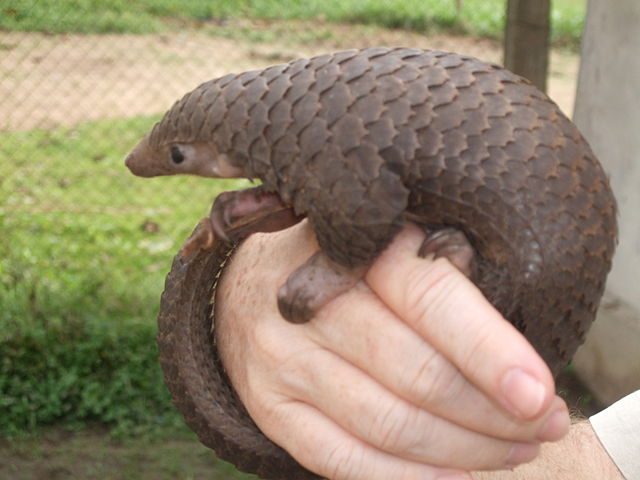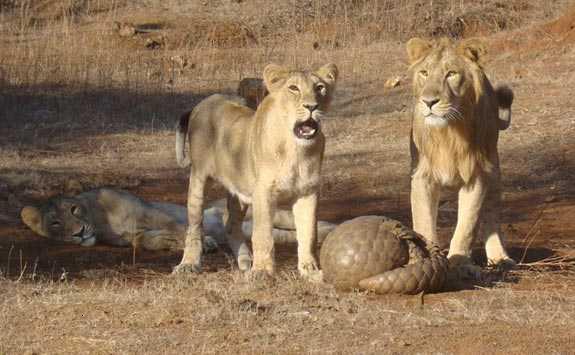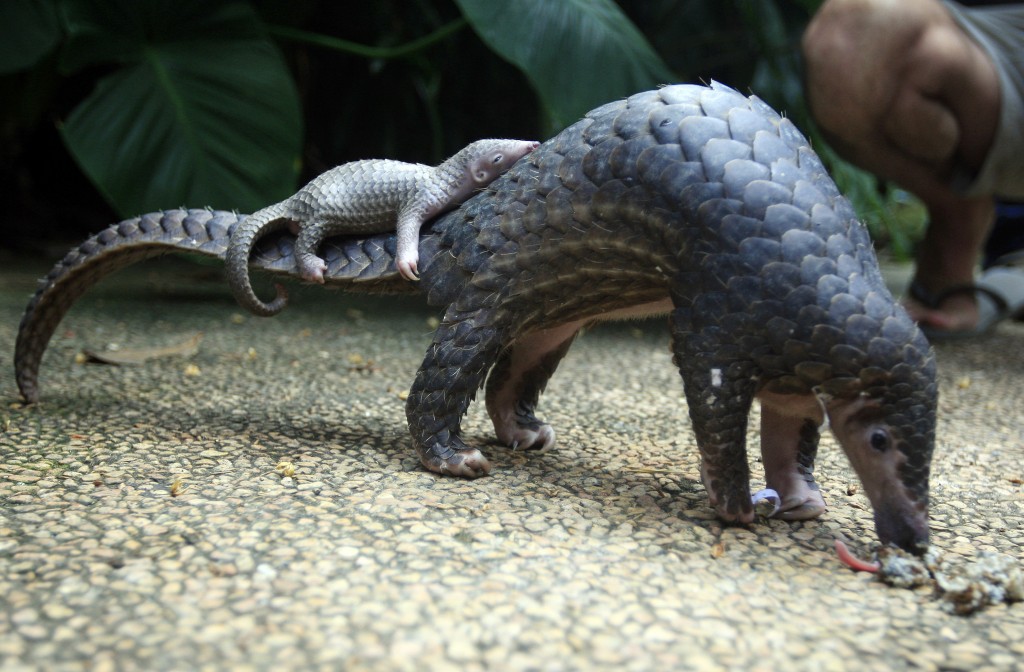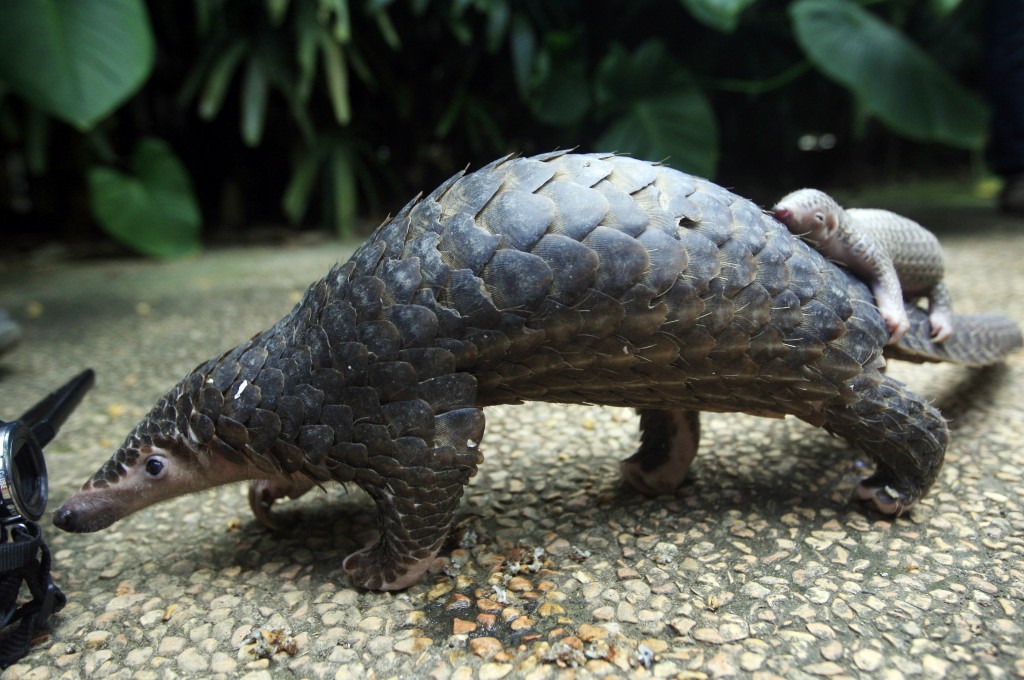Cool Facts About the Pangolin
What is it exactly?
The Pangolin (also known as a “scaly anteater”) … is it a reptile? It has all those scales …. You would think so, wouldn’t you? But no, it is not a reptile. It is a mammal. Weird, huh? Yeah, that surprised me too. Here are some more cool facts about the Pangolin you didn’t know you’d want to know. 
Cool Facts About the Pangolin – Description
- Pangolins are native to Asia and Africa.
- Their bodies are covered in large, hardened, overlapping plate-like scales. These scales are made of keratin, which is the same material found in human fingernails. The scaled body is comparable to a pine cone.
- The pangolin’s long tongue (up to 16 inches), which is coated with a sticky substance, captures the ants and termites so they can be swallowed.
- They have a keen sense of smell which easily points them to ant and termite nests, and they use their claws to dig the insects out of their mounds.
- The pangolin has a small head and no external ears, though his hearing is excellent.
- Pangolins have a very poor sense of vision, and therefore rely heavily on smell and hearing.
- The Pangolin’s legs are short and they have sharp claws which they use for burrowing into termite and ant mounds, as well as climbing. Their front claws are so large that their anterior feet are not useful for walking. The animal uses its long tail to counterbalance its torso as it walks on its two hind legs.
- He has no teeth, because his stomach is specially designed to grind food. He helps the process along by eating small stones and sand that assist with grinding.
- The size of pangolins varies by species, ranging from 30 to 100 centimetres (12 to 39 in), with females generally being smaller than males.
- The average weight for a Pangolin is 30 to 40 pounds.
- They can live up to 20 years.
Cool Facts About the Pangolin – Defense
- When threatened, the Pangolin is able to roll itself up into a tight ball, and they can also use their sharp scales to powerfully slice and dice anything inserted between them.
- When curled up into a ball, its face is tucked under its tail.
- Pangolins can also emit a noxious-smelling acid from glands near the anus, similar to the spray of a skunk. Pangolins cannot, however, spray this acid as skunks do.

Cool Facts About the Pangolin – Behavior
- Pangolins are noctural creatures, staying tucked away in their burrows during daylight hours and do their hunting at night.
- Arboreal pangolins live in hollow trees, whereas the ground dwelling species dig tunnels underground, to a depth of 3.5 metres (11 feet).
- Pangolins are also good swimmers.
Cool Facts About the Pangolin – Reproduction
- Pangolins are solitary and meet only to mate.
- Males are larger than females, weighing up to 50% more.
- They typically mate once each year, usually during the summer or fall months.
- Rather than the males seeking out the females, males mark their location with urine or feces and the females will find them.
- If there is competition over a female, the males will use their tails as clubs to fight for the opportunity to mate with her.
- Gestation lasts for approximately 120–150 days. African pangolin females usually give birth to a single offspring at a time, but the Asiatic species may give birth from one to three.
- Weight at birth is 80 to 450 g (2.8 to 15.9 oz) and the average length is 6 inches (150 mm).
- At the time of birth, the scales are soft and white. After several days, they harden and darken to resemble those of an adult pangolin.

- Infants rest in the center of the mother’s rolled-up body to nurse.
- The young cling to the mother’s tail as she moves about, although in burrowing species, they remain in the burrow for the first two to four weeks of life.
- Weaning takes place at approximately three months of age, at which stage the young begin to eat insects in addition to nursing. This is when they begin to accompany their mother while she hunts.
- If the mother senses a threat, the baby slips under her and is protected when she rolls her body into a self-defense posture.
- At two years of age, the offspring are sexually mature and are abandoned by the mother.

Not-So-Cool Facts About the Pangolin – Threats
This unique little creature is falling prey to illegal hunting and poaching and is one of the most trafficked animals in the world. The meat and scales of pangolins are in high demand on the black market, especially in China and Vietnam, despite international trade bans. Conservationists estimate that over a million pangolins have been taken from the wild in just the last 10 years. Though pangolin are protected by an international ban on their trade, populations have suffered from illegal trafficking due to unfounded beliefs in Asia that their ground-up scales can stimulate lactation or cure cancer or asthma. In the past decade there have been numerous seizures of illegally trafficked pangolin and pangolin meat in Asia. In one such incident during 2013, 10,000 kilograms of pangolin meat was seized from a Chinese vessel that ran aground in the Philippines.
- Pangolins were added to the Zoological Society of London‘s list of genetically distinct and endangered mammals in 2010.
- All eight species of pangolin are classified by the IUCN as threatened to extinction, while two are classified as critically endangered.
SOURCE: http://en.wikipedia.org/wiki/Pangolin
***************************
I hope you have enjoyed, “Cool Facts About the Pangolin“
You might also like to read, 22 Freakish Facts About Giraffes You Will be Glad You Know
♥♥♥♥♥
MY QUESTION FOR YOU TODAY: Are there any animals you know of that you would like to see featured here on my blog? Is there any creature that you would like to learn more about? Or, do you have a story you would like to submit about a pet you have? I would love to hear from you in the comment section below, or please email me directly at jeanne@jeannemelanson.com
*************************
*** Please leave a comment below and remember to share. ***
It’s just sexy!
As always, thank you for taking the time to visit my blog!
♥ PEACE ♥
- Mindful Travel With Your Dog This Holiday Season - December 23, 2019
- A-Z of Australia’s Endangered Wildlife - December 20, 2019
- Teaching Your Kids How to Walk the Dog Safely - December 2, 2019

Love them! ? Hopefully they can be saved before it’s too late ?!! Ty for sharing!! Save all animals!!
Thanks for your sentiment, Nancy. I appreciate you stopping by. Peace
I wish we had pangolins in the southeast to get rid of all the epic fire ant mounds!
I enjoyed reading about pangolins. Have you ever done a blog post about solenodons? I have told people for years that they are my favourite animal. Also interesting that one of them which was thought extinct in the 1940s reappeared around 40 years later.
Wow, pangolins are cool, they remind me of an anteater. I can hardly picture them walking on their hind feet. I hope something is done to keep them from extinction. People are the highest species on the animal kingdom fiefdom and we are the stupidest of them all. Thanks for the excellent article Jeannie. The Birdman
I have never seen anything like this before. It is kind of cute. Lol
I’ve never seen one of those before! Pretty cool.